Analysis of Cybersecurity Reform Proposals for the U.S. Government
VerifiedAdded on 2022/07/28
|5
|1023
|29
Report
AI Summary
This report analyzes the Cyberspace Solarium Committee's tactical plan to shield the United States from cyber-attacks, as defined by the John S. McCain National Defence Authorization Act for Fiscal Year 2019. The paper focuses on the first pillar of the reform: reforming the U.S. Government's structure and organization for cyberspace. It examines recommendations such as creating new cybersecurity committees in Congress and establishing a National Cyber Director. The analysis highlights both the promises of the reform, such as strengthening cybersecurity and building a national cybersecurity workforce, and potential cons, including the time-consuming nature of the changes and the impact on public and private sectors, especially during the pandemic. The report concludes with a call for the commission to consider the post-pandemic effects when planning and making suggestions.
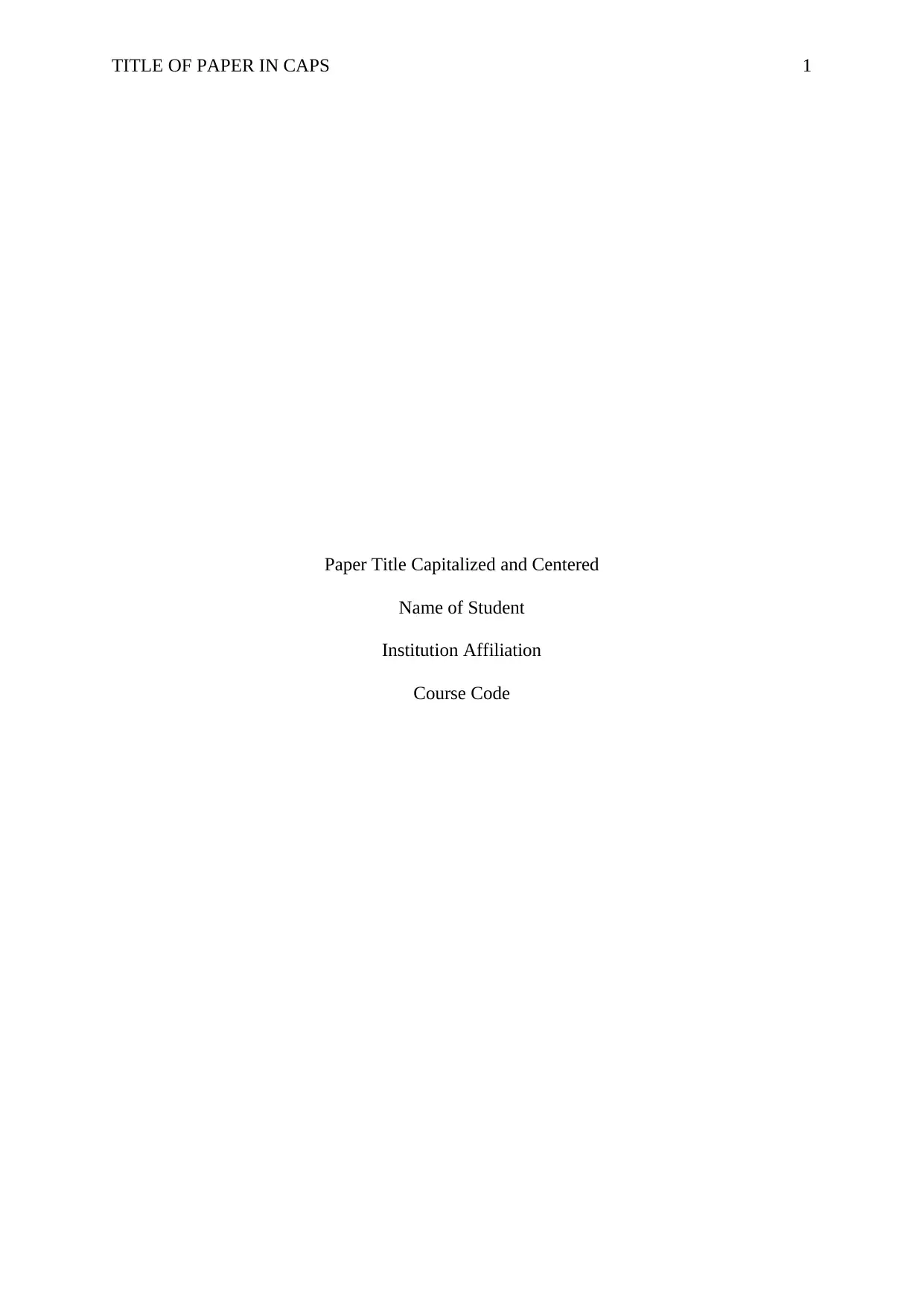
TITLE OF PAPER IN CAPS 1
Paper Title Capitalized and Centered
Name of Student
Institution Affiliation
Course Code
Paper Title Capitalized and Centered
Name of Student
Institution Affiliation
Course Code
Paraphrase This Document
Need a fresh take? Get an instant paraphrase of this document with our AI Paraphraser
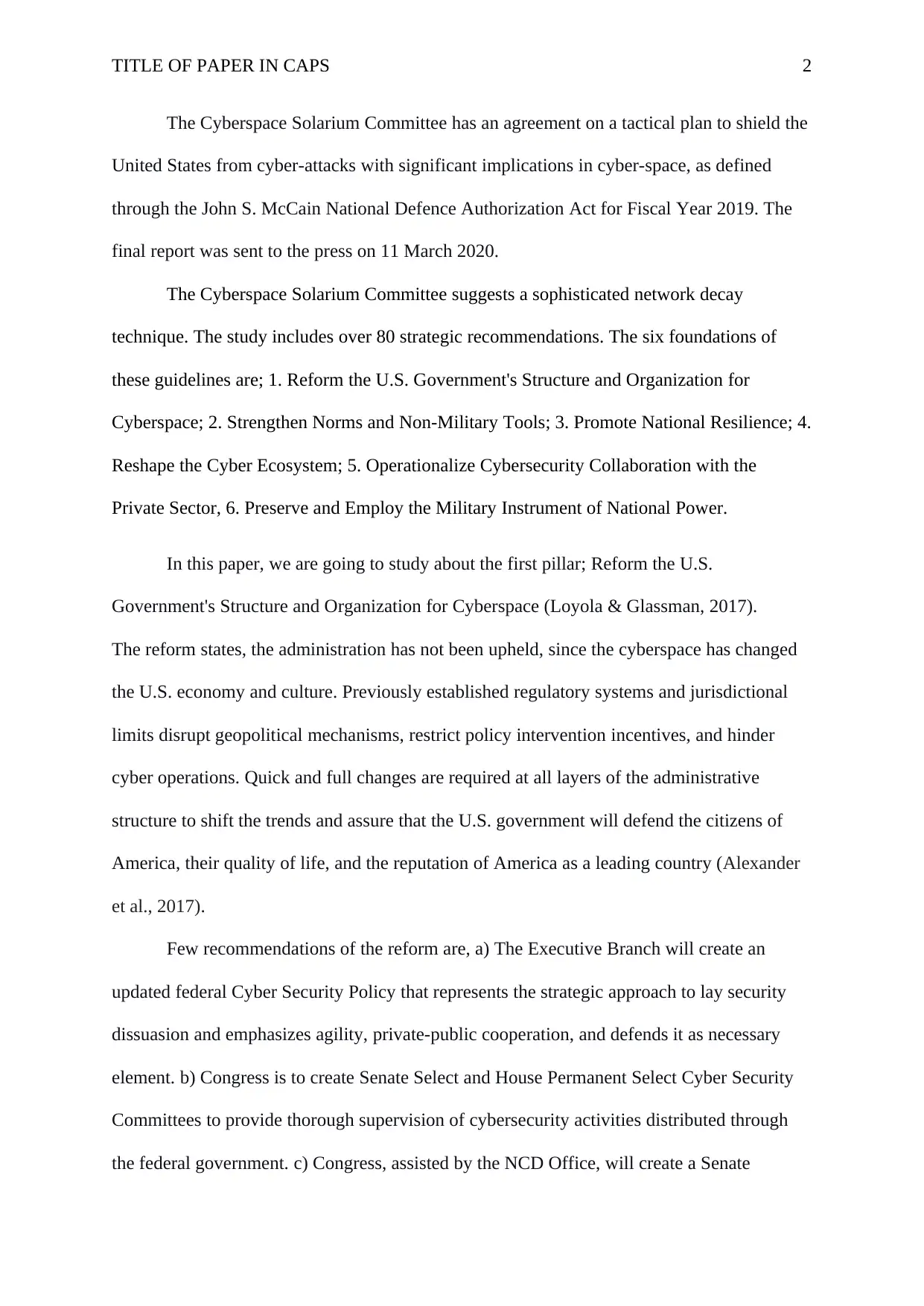
TITLE OF PAPER IN CAPS 2
The Cyberspace Solarium Committee has an agreement on a tactical plan to shield the
United States from cyber-attacks with significant implications in cyber-space, as defined
through the John S. McCain National Defence Authorization Act for Fiscal Year 2019. The
final report was sent to the press on 11 March 2020.
The Cyberspace Solarium Committee suggests a sophisticated network decay
technique. The study includes over 80 strategic recommendations. The six foundations of
these guidelines are; 1. Reform the U.S. Government's Structure and Organization for
Cyberspace; 2. Strengthen Norms and Non-Military Tools; 3. Promote National Resilience; 4.
Reshape the Cyber Ecosystem; 5. Operationalize Cybersecurity Collaboration with the
Private Sector, 6. Preserve and Employ the Military Instrument of National Power.
In this paper, we are going to study about the first pillar; Reform the U.S.
Government's Structure and Organization for Cyberspace (Loyola & Glassman, 2017).
The reform states, the administration has not been upheld, since the cyberspace has changed
the U.S. economy and culture. Previously established regulatory systems and jurisdictional
limits disrupt geopolitical mechanisms, restrict policy intervention incentives, and hinder
cyber operations. Quick and full changes are required at all layers of the administrative
structure to shift the trends and assure that the U.S. government will defend the citizens of
America, their quality of life, and the reputation of America as a leading country (Alexander
et al., 2017).
Few recommendations of the reform are, a) The Executive Branch will create an
updated federal Cyber Security Policy that represents the strategic approach to lay security
dissuasion and emphasizes agility, private-public cooperation, and defends it as necessary
element. b) Congress is to create Senate Select and House Permanent Select Cyber Security
Committees to provide thorough supervision of cybersecurity activities distributed through
the federal government. c) Congress, assisted by the NCD Office, will create a Senate
The Cyberspace Solarium Committee has an agreement on a tactical plan to shield the
United States from cyber-attacks with significant implications in cyber-space, as defined
through the John S. McCain National Defence Authorization Act for Fiscal Year 2019. The
final report was sent to the press on 11 March 2020.
The Cyberspace Solarium Committee suggests a sophisticated network decay
technique. The study includes over 80 strategic recommendations. The six foundations of
these guidelines are; 1. Reform the U.S. Government's Structure and Organization for
Cyberspace; 2. Strengthen Norms and Non-Military Tools; 3. Promote National Resilience; 4.
Reshape the Cyber Ecosystem; 5. Operationalize Cybersecurity Collaboration with the
Private Sector, 6. Preserve and Employ the Military Instrument of National Power.
In this paper, we are going to study about the first pillar; Reform the U.S.
Government's Structure and Organization for Cyberspace (Loyola & Glassman, 2017).
The reform states, the administration has not been upheld, since the cyberspace has changed
the U.S. economy and culture. Previously established regulatory systems and jurisdictional
limits disrupt geopolitical mechanisms, restrict policy intervention incentives, and hinder
cyber operations. Quick and full changes are required at all layers of the administrative
structure to shift the trends and assure that the U.S. government will defend the citizens of
America, their quality of life, and the reputation of America as a leading country (Alexander
et al., 2017).
Few recommendations of the reform are, a) The Executive Branch will create an
updated federal Cyber Security Policy that represents the strategic approach to lay security
dissuasion and emphasizes agility, private-public cooperation, and defends it as necessary
element. b) Congress is to create Senate Select and House Permanent Select Cyber Security
Committees to provide thorough supervision of cybersecurity activities distributed through
the federal government. c) Congress, assisted by the NCD Office, will create a Senate
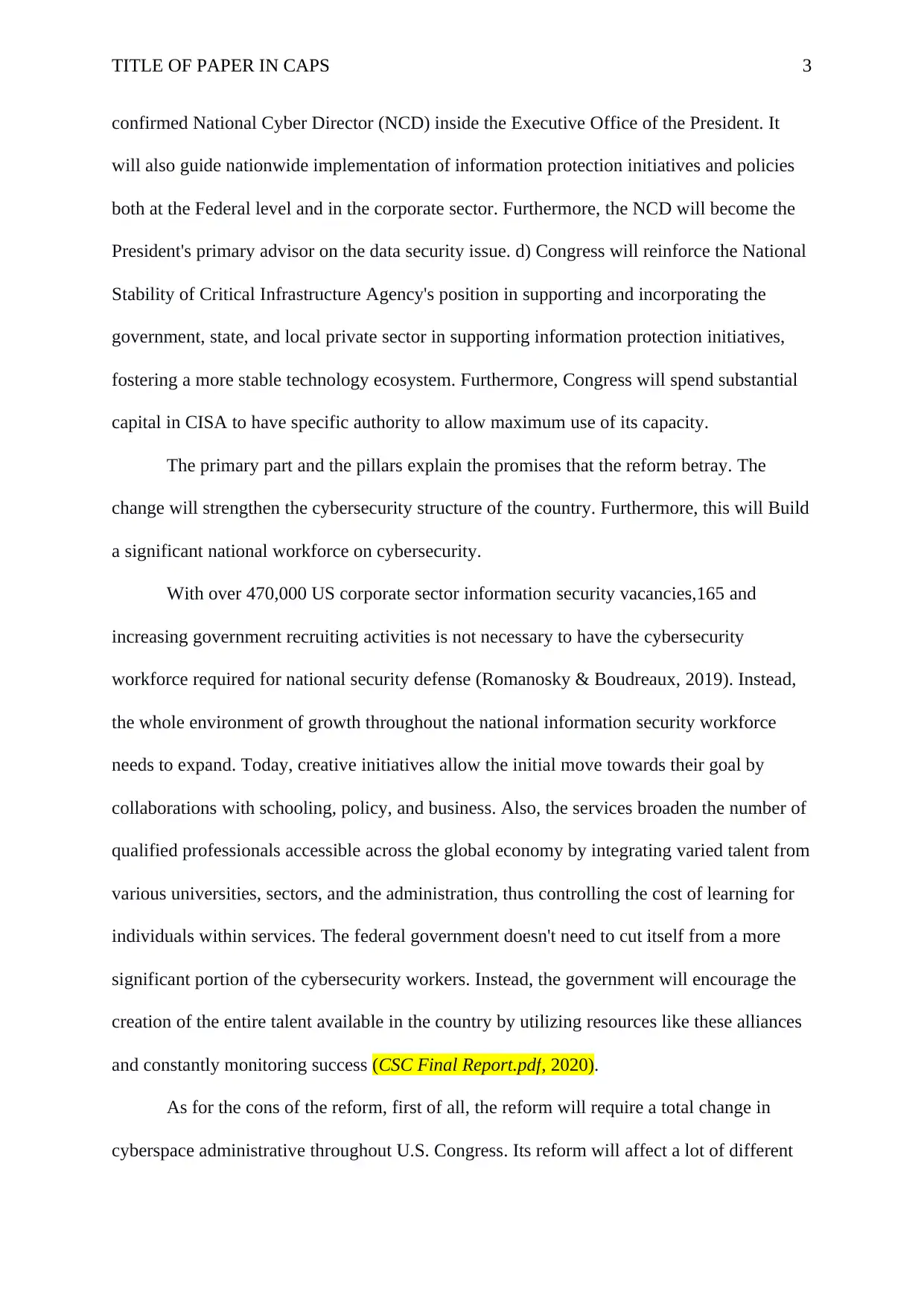
TITLE OF PAPER IN CAPS 3
confirmed National Cyber Director (NCD) inside the Executive Office of the President. It
will also guide nationwide implementation of information protection initiatives and policies
both at the Federal level and in the corporate sector. Furthermore, the NCD will become the
President's primary advisor on the data security issue. d) Congress will reinforce the National
Stability of Critical Infrastructure Agency's position in supporting and incorporating the
government, state, and local private sector in supporting information protection initiatives,
fostering a more stable technology ecosystem. Furthermore, Congress will spend substantial
capital in CISA to have specific authority to allow maximum use of its capacity.
The primary part and the pillars explain the promises that the reform betray. The
change will strengthen the cybersecurity structure of the country. Furthermore, this will Build
a significant national workforce on cybersecurity.
With over 470,000 US corporate sector information security vacancies,165 and
increasing government recruiting activities is not necessary to have the cybersecurity
workforce required for national security defense (Romanosky & Boudreaux, 2019). Instead,
the whole environment of growth throughout the national information security workforce
needs to expand. Today, creative initiatives allow the initial move towards their goal by
collaborations with schooling, policy, and business. Also, the services broaden the number of
qualified professionals accessible across the global economy by integrating varied talent from
various universities, sectors, and the administration, thus controlling the cost of learning for
individuals within services. The federal government doesn't need to cut itself from a more
significant portion of the cybersecurity workers. Instead, the government will encourage the
creation of the entire talent available in the country by utilizing resources like these alliances
and constantly monitoring success (CSC Final Report.pdf, 2020).
As for the cons of the reform, first of all, the reform will require a total change in
cyberspace administrative throughout U.S. Congress. Its reform will affect a lot of different
confirmed National Cyber Director (NCD) inside the Executive Office of the President. It
will also guide nationwide implementation of information protection initiatives and policies
both at the Federal level and in the corporate sector. Furthermore, the NCD will become the
President's primary advisor on the data security issue. d) Congress will reinforce the National
Stability of Critical Infrastructure Agency's position in supporting and incorporating the
government, state, and local private sector in supporting information protection initiatives,
fostering a more stable technology ecosystem. Furthermore, Congress will spend substantial
capital in CISA to have specific authority to allow maximum use of its capacity.
The primary part and the pillars explain the promises that the reform betray. The
change will strengthen the cybersecurity structure of the country. Furthermore, this will Build
a significant national workforce on cybersecurity.
With over 470,000 US corporate sector information security vacancies,165 and
increasing government recruiting activities is not necessary to have the cybersecurity
workforce required for national security defense (Romanosky & Boudreaux, 2019). Instead,
the whole environment of growth throughout the national information security workforce
needs to expand. Today, creative initiatives allow the initial move towards their goal by
collaborations with schooling, policy, and business. Also, the services broaden the number of
qualified professionals accessible across the global economy by integrating varied talent from
various universities, sectors, and the administration, thus controlling the cost of learning for
individuals within services. The federal government doesn't need to cut itself from a more
significant portion of the cybersecurity workers. Instead, the government will encourage the
creation of the entire talent available in the country by utilizing resources like these alliances
and constantly monitoring success (CSC Final Report.pdf, 2020).
As for the cons of the reform, first of all, the reform will require a total change in
cyberspace administrative throughout U.S. Congress. Its reform will affect a lot of different
⊘ This is a preview!⊘
Do you want full access?
Subscribe today to unlock all pages.

Trusted by 1+ million students worldwide
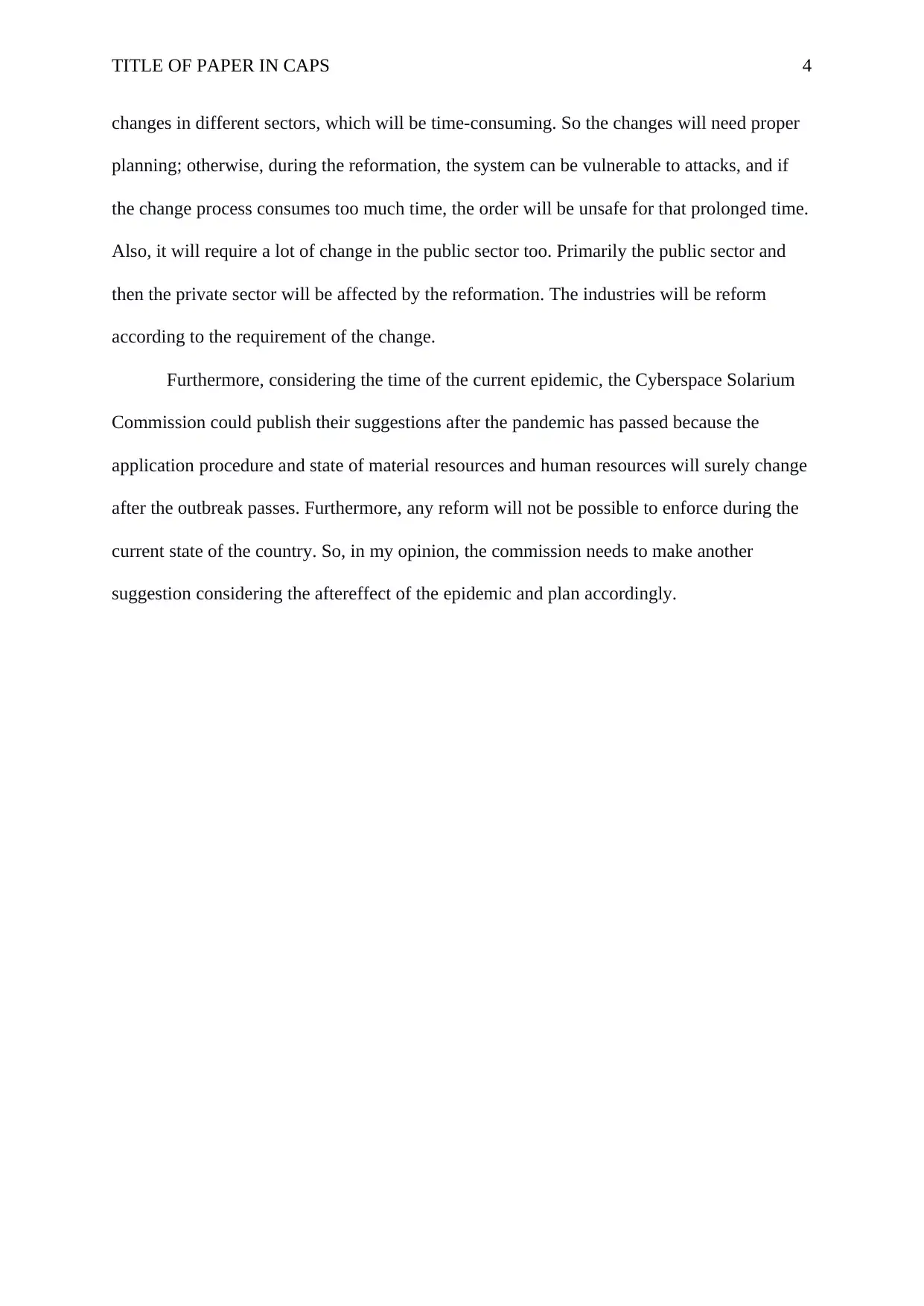
TITLE OF PAPER IN CAPS 4
changes in different sectors, which will be time-consuming. So the changes will need proper
planning; otherwise, during the reformation, the system can be vulnerable to attacks, and if
the change process consumes too much time, the order will be unsafe for that prolonged time.
Also, it will require a lot of change in the public sector too. Primarily the public sector and
then the private sector will be affected by the reformation. The industries will be reform
according to the requirement of the change.
Furthermore, considering the time of the current epidemic, the Cyberspace Solarium
Commission could publish their suggestions after the pandemic has passed because the
application procedure and state of material resources and human resources will surely change
after the outbreak passes. Furthermore, any reform will not be possible to enforce during the
current state of the country. So, in my opinion, the commission needs to make another
suggestion considering the aftereffect of the epidemic and plan accordingly.
changes in different sectors, which will be time-consuming. So the changes will need proper
planning; otherwise, during the reformation, the system can be vulnerable to attacks, and if
the change process consumes too much time, the order will be unsafe for that prolonged time.
Also, it will require a lot of change in the public sector too. Primarily the public sector and
then the private sector will be affected by the reformation. The industries will be reform
according to the requirement of the change.
Furthermore, considering the time of the current epidemic, the Cyberspace Solarium
Commission could publish their suggestions after the pandemic has passed because the
application procedure and state of material resources and human resources will surely change
after the outbreak passes. Furthermore, any reform will not be possible to enforce during the
current state of the country. So, in my opinion, the commission needs to make another
suggestion considering the aftereffect of the epidemic and plan accordingly.
Paraphrase This Document
Need a fresh take? Get an instant paraphrase of this document with our AI Paraphraser
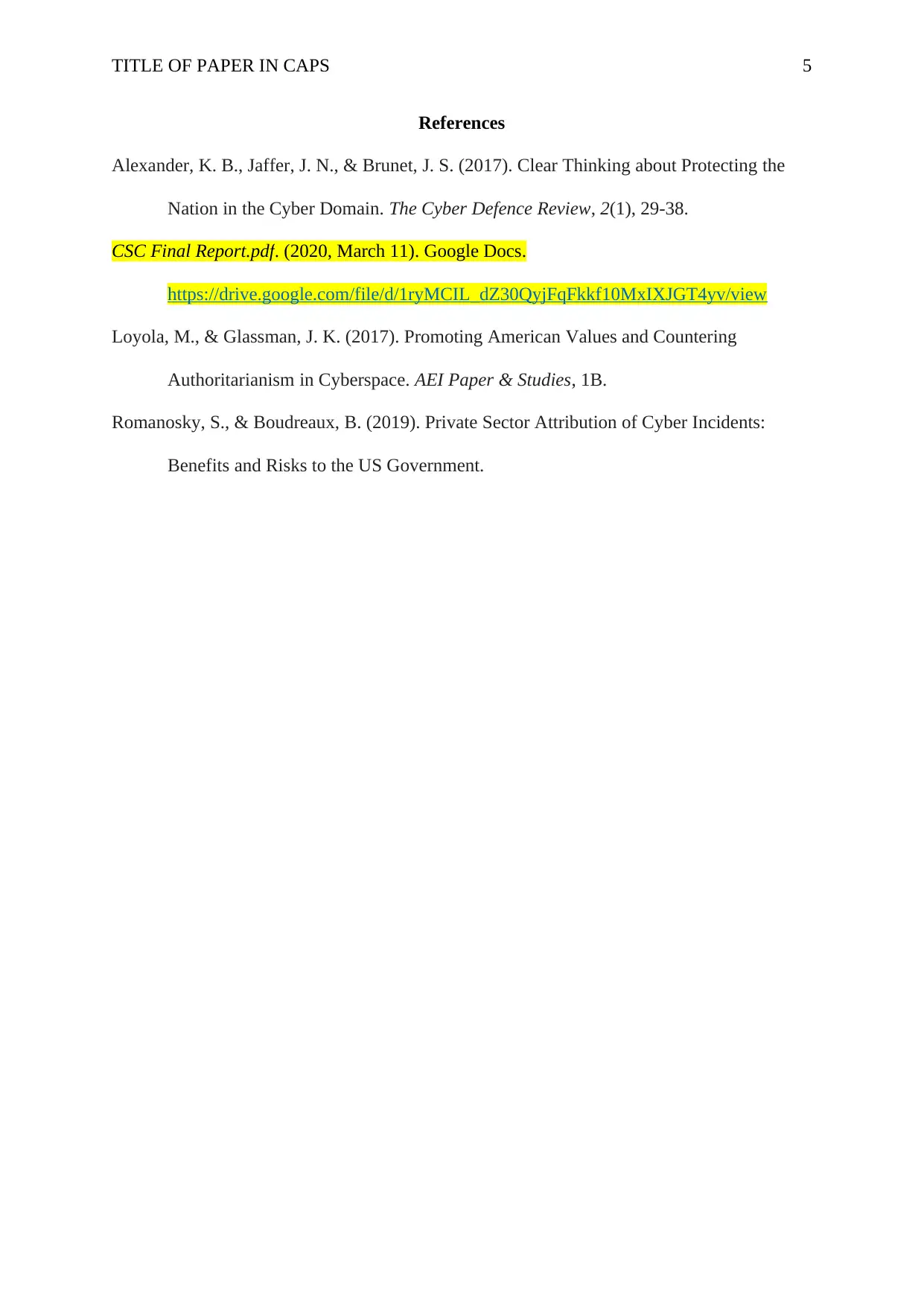
TITLE OF PAPER IN CAPS 5
References
Alexander, K. B., Jaffer, J. N., & Brunet, J. S. (2017). Clear Thinking about Protecting the
Nation in the Cyber Domain. The Cyber Defence Review, 2(1), 29-38.
CSC Final Report.pdf. (2020, March 11). Google Docs.
https://drive.google.com/file/d/1ryMCIL_dZ30QyjFqFkkf10MxIXJGT4yv/view
Loyola, M., & Glassman, J. K. (2017). Promoting American Values and Countering
Authoritarianism in Cyberspace. AEI Paper & Studies, 1B.
Romanosky, S., & Boudreaux, B. (2019). Private Sector Attribution of Cyber Incidents:
Benefits and Risks to the US Government.
References
Alexander, K. B., Jaffer, J. N., & Brunet, J. S. (2017). Clear Thinking about Protecting the
Nation in the Cyber Domain. The Cyber Defence Review, 2(1), 29-38.
CSC Final Report.pdf. (2020, March 11). Google Docs.
https://drive.google.com/file/d/1ryMCIL_dZ30QyjFqFkkf10MxIXJGT4yv/view
Loyola, M., & Glassman, J. K. (2017). Promoting American Values and Countering
Authoritarianism in Cyberspace. AEI Paper & Studies, 1B.
Romanosky, S., & Boudreaux, B. (2019). Private Sector Attribution of Cyber Incidents:
Benefits and Risks to the US Government.
1 out of 5
Your All-in-One AI-Powered Toolkit for Academic Success.
+13062052269
info@desklib.com
Available 24*7 on WhatsApp / Email
![[object Object]](/_next/static/media/star-bottom.7253800d.svg)
Unlock your academic potential
Copyright © 2020–2025 A2Z Services. All Rights Reserved. Developed and managed by ZUCOL.